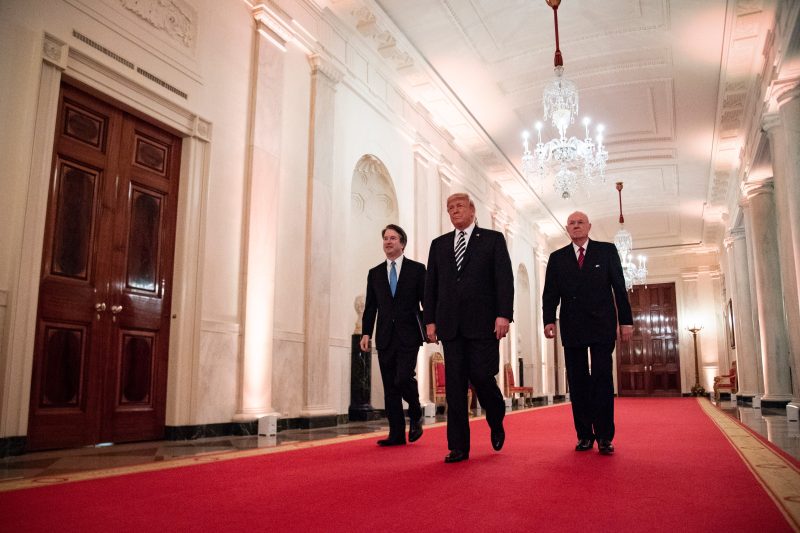Retired Justice Anthony M. Kennedy was in the front row of the Supreme Court’s marble-columned courtroom last fall when the justices reconsidered a question he had answered years ago: the reach of the Clean Water Act’s protections of the nation’s streams and wetlands.
Since 2006, industry challenges of Kennedy’s opinion, which expanded the government’s ability to set pollution regulations in environmentally sensitive areas, had consistently failed.
But it was a different Supreme Court that assembled last October. And when it handed down a decision six months later, the protections Kennedy had established were significantly stymied. Not a single justice — including two former Kennedy clerks nominated by President Donald Trump — endorsed the rules Kennedy had written 17 years earlier.
And so it goes across a wide swath of American law.
During his three decades on the court, Kennedy, nominated by President Ronald Reagan in 1988, was almost sure to be found in the majorities that prevailed on the nation’s most monumental concerns. A center-right moderate who sometimes sided with the court’s liberals, he cast the vote that established a constitutional right for same-sex couples to marry and determined how far government may intrude on the right to an abortion, and whether attempts to curtail the corrupting influence of campaign contributions violated free speech. Kennedy controlled when universities could take race into account to seek diverse student bodies, and how schools could sort pupils to ensure desegregation.
Other Kennedy votes shielded juveniles and the intellectually disabled from the death penalty, although he refused to find capital punishment unconstitutional. His mixed feelings on gun control were one reason the court hesitated to take such cases for more than a decade.
“Frankly, it’s everything important,” one of Kennedy’s former clerks, University of Virginia law professor Richard Re, said of the cases whose outcome rested on the justice’s vote.
But on a court that has moved decidedly to the right, Kennedy’s mark is fading fast — and is already erased in some areas. To a large extent, Justices Neil M. Gorsuch and Brett M. Kavanaugh — former clerks who are more conservative than their old boss — are part of the reason.
“I’m sure [Kennedy] knew no replacement was going to be exactly like him, and he had to have some sense which areas were likely to change,” said Leah Litman, a former Kennedy clerk who now teaches law at the University of Michigan. “I don’t know that he would have predicted how quickly it would change.”
Kennedy, 87, has not spoken publicly about the changes on the court and did not respond to interview requests for this story.
The five years since he retired “feels more like a hundred,” said Lisa Heinzerling, an environmental law expert at Georgetown University Law Center. Kennedy’s views, she said, “are nowhere to be found on this court anymore.”
For more than a dozen years, it was Kennedy who cast the deciding vote when colleagues on the left and right were equally divided (in about two-thirds of those cases, studies showed, he leaned right). But six justices on the current court are more conservative than Kennedy, and three are on the left.
That means fewer opportunities for a median justice to break a 4 to 4 tie.
Roe v. Wade was the most notable of the court’s landmark decisions to tumble because of Kennedy’s absence in 2022.
Kennedy had joined with fellow Republican-nominated Justices Sandra Day O’Connor and David Souter 30 years earlier to protect Roe, holding that overturning the constitutional right to abortion would be too big a shock to society and endanger the court’s reputation for steadfastness.
But last year, only 18 months after Trump’s third appointment, the high court did just that. Five justices said Roe, and the follow-up compromise Kennedy helped craft in Casey v. Planned Parenthood in 1992, did not deserve the deference the court usually awards to past decisions.
“Roe was on a collision course with the Constitution from the day it was decided, Casey perpetuated its errors, and those errors do not concern some arcane corner of the law of little importance to the American people,” wrote Justice Samuel A. Alito Jr., who was joined by Justices Clarence Thomas, Gorsuch, Kavanaugh and Trump’s final choice for the court, Amy Coney Barrett.
Kavanaugh penned a concurrence that professed “deep and unyielding respect” for his old boss and the other justices who wrote Casey. In their dissent to Alito’s ruling, the court’s three liberals said Kavanaugh’s sentiment rang hollow.
“O’Connor, Kennedy, and Souter — they were judges of wisdom,” wrote Justices Stephen G. Breyer, Sonia Sotomayor and Elena Kagan. “They would not have won any contests for the kind of ideological purity some court watchers want Justices to deliver. But if there were awards for Justices who left this Court better than they found it? … Sign those Justices up.”
Other changes attributable to Kennedy’s departure have drawn less attention. For years, Kennedy was alone among the conservative justices in believing extreme partisan gerrymandering — drawing legislative districts to favor the political party in power — might violate a voter’s constitutional rights and warrant the intervention of federal courts.
Less than a year after their former boss’s retirement, Gorsuch and Kavanaugh voted with the court’s other conservatives to say the Constitution doesn’t assign federal judges a role in making such determinations.
On affirmative action, Kennedy in 2016 surprised conservatives and liberals alike by finding that the University of Texas could continue to consider race a factor in admitting a diverse student body. “Considerable deference is owed to a university in defining those intangible characteristics, like student body diversity, that are central to its identity and educational mission,” he wrote.
This summer, the court found the opposite, with Gorsuch and Kavanaugh again in the majority. “Universities may define their missions as they see fit. The Constitution defines ours,” Chief Justice John G. Roberts Jr. wrote. “Courts may not license separating students on the basis of race without an exceedingly persuasive justification that is measurable and concrete enough to permit judicial review.”
Heinzerling, the Georgetown law professor, said the court similarly has gone beyond where she thinks Kennedy would be on environmental law. Kennedy was not a sure vote for that side, she said, and had become skeptical of deferring to the expertise of federal agencies in some cases.
But he would not be comfortable with the way the court in May defined the Clean Water Act, Heinzerling said, or with an earlier decision that cast doubt on the Environmental Protection Agency’s ability to combat climate change without an explicit grant of authority from Congress.
Kennedy’s skepticism about the power of government agencies, Heinzerling said, is “a pretty far cry” from the new court’s more detailed doctrine that agencies are forbidden from acting on major issues without a specific authorization from Congress.
Kennedy’s legacy also may be eroded on issues involving the death penalty and juvenile justice.
He was among the 5 to 4 majority that forbade the death penalty for crimes committed by people younger than 18, and declared unconstitutional state laws that draw a bright line on IQ-test results to decide intellectual eligibility for capital punishment. He was in the majority casting doubt on life without parole for younger defendants. Without Kennedy and the late Justice Ruth Bader Ginsburg on the bench, it has become extremely rare for a death row inmate to be granted a stay of execution.
Kennedy wrote another 5 to 4 decision barring the death penalty for child rapists, continuing the court’s trend of narrowing the kinds of crimes subject to capital punishment. But conservative state legislatures are moving in the opposite direction, said Robert Dunham, former executive director of the Death Penalty Information Center. Most prominent is a new Florida law restoring capital punishment for the rape of a child, passed with the backing of Gov. Ron DeSantis (R), that could bring the issue back to the court for reconsideration.
“That is an intentional test. They think the court’s going to blink,” Dunham said.
Erwin Chemerinsky, dean of the law school at the University of California, Berkeley, once joked that, if allowed, he would put Kennedy’s photo on his Supreme Court filings to enhance his chances of winning. Both he and Dunham noted the combination of Kennedy being replaced by Kavanaugh, and Ginsburg by Barrett, as pivotal to the reorientation of the court.
The arrival of the two conservative successors gave conservatives more leeway to take controversial cases, and still prevail even if not all of the court’s right flank agrees, Chemerinsky said. That was the case with Roe, where Roberts voted with his fellow conservatives to restrict abortion rights but not to get rid of the precedent.
Chemerinsky noted that in Kennedy’s last term on the court, he did not side with the liberals in any of the close cases. He thinks it is difficult to predict with certainty how the justice would have voted on some of the cases that have come before the court since then.
For instance, Kennedy wrote all of the court’s major decisions establishing LBGTQ rights. But even in the June ruling where the court sided with a web site designer who said it violated her free speech rights to be forced to create work for same-sex weddings, Chemerinksy said it is unclear where Kennedy would have come down.
“Kennedy’s legacy is in the area of gay and lesbian rights, so you might think he would have been with the dissenters,” Chemerinsky said. “But on the other hand, he was also a strong free speech advocate.”
Litman said she is not certain either. But she said she believes he would have had qualms about Gorsuch’s opinion in the case, 303 Creative v. Elenis, and searched for a more limited solution.
That decision “was opening a new direction that doesn’t seem like it’s going to stop with 303 Creative,” and could endanger other protections, Litman said.
Again, Kennedy’s former clerks were part of the majority.
Six of the nine justices are former Supreme Court clerks. Chemerinsky believes Roberts generally aligns with William H. Rehnquist, his old boss. But he considers Kagan less liberal than Justice Thurgood Marshall, for whom she clerked, and Ketanji Brown Jackson more liberal than her predecessor Breyer,
It might be even more unlikely to find a former clerk who would mimic Kennedy’s votes. “AMK was an independent thinker, a creative thinker — he saw tensions in the law, he saw both sides,” said Re, the former clerk who is now a U-Va. law professor. “I think it’s hard to find any Kennedy clerk who agrees with all of the boss’s big decisions or even the great majority of the boss’s big decisions.”
O’Connor was the median justice before Kennedy. In interviews after she retired, she made it clear she was not happy when the court rejected some of the compromise rulings she had rendered.
“What would you feel? I’d be a little bit disappointed,” she told an interviewer. “If you think you’ve been helpful, and then it’s dismantled, you think, ‘Oh, dear.’ But life goes on. It’s not always positive.”
Re thinks Kennedy may have a different outlook. “His view is not of someone who thinks they own the shop and they’re trying to watch the new shop manager,” he said.
Trump’s staffers sought to ensure Kennedy would feel comfortable retiring, choosing his clerk Gorsuch for the first vacancy on the court, replacing the late Antonin Scalia, and making sure he knew Kavanaugh and another former clerk were in the running to be nominated when Kennedy himself stepped aside.
“I tend to think about what this means for his own legacy,” said Litman. “But he made a decision to retire when he did knowing what the world was in front of him. That was a decision with consequence.”
Ann E. Marimow contributed to this report.



























